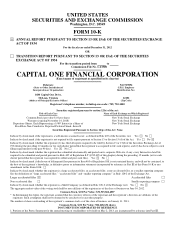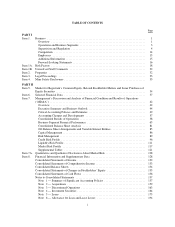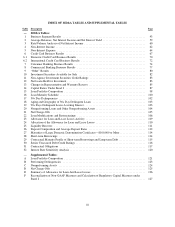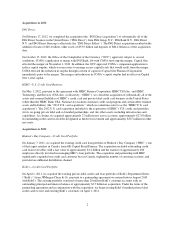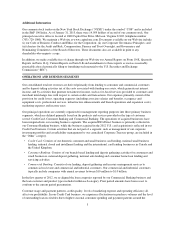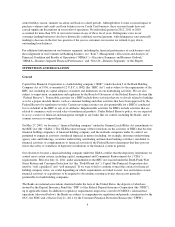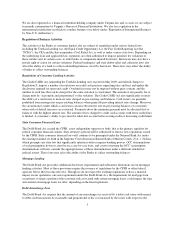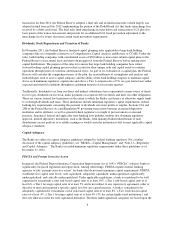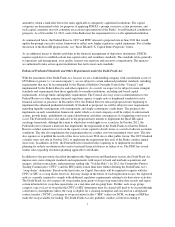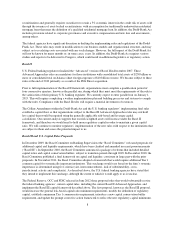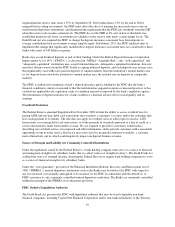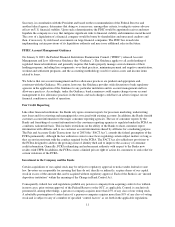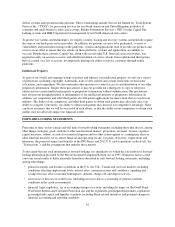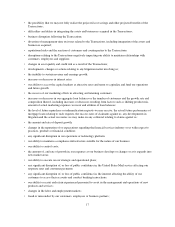Capital One 2012 Annual Report Download - page 26
Download and view the complete annual report
Please find page 26 of the 2012 Capital One annual report below. You can navigate through the pages in the report by either clicking on the pages listed below, or by using the keyword search tool below to find specific information within the annual report.amount by which a bank falls below the ratios applicable to adequately capitalized institutions. The capital
categories are determined solely for purposes of applying FDICIA’s prompt corrective action provisions, and
such capital categories may not constitute an accurate representation of the Banks’ overall financial condition or
prospects. As of December 31, 2012, each of the Banks met the requirements for a well-capitalized institution.
As summarized below, the Federal Reserve, OCC and FDIC released a proposed rule in June 2012 that would
update the prompt corrective action framework to reflect new, higher regulatory capital minimums. For a further
discussion of the Basel III proposed rule, see “Basel III and U.S. Capital Rules Proposals” below.
As an additional means to identify problems in the financial management of depository institutions, FDICIA
requires regulators to establish certain non-capital safety and soundness standards. The standards relate generally
to operations and management, asset quality, interest rate exposure and executive compensation. The agencies
are authorized to take action against institutions that fail to meet such standards.
Enhanced Prudential Standards and Other Requirements under the Dodd-Frank Act
With the enactment of the Dodd-Frank Act, because we are a bank holding company with consolidated assets of
$50 billion or greater (a “covered company”), we are subject to certain enhanced prudential standards, including
requirements that may be recommended by the Financial Stability Oversight Council (the “Council”) and
implemented by the Federal Reserve and other regulators. As a result, we expect to be subject to more stringent
standards and requirements than those applicable for smaller institutions, including risk-based capital
requirements, leverage limits and liquidity requirements. The Council also may issue recommendations to the
Federal Reserve or other primary financial regulatory agency to apply new or heightened standards to risky
financial activities or practices. In December 2011, the Federal Reserve released proposed rules beginning to
implement the enhanced prudential standards. If finalized as proposed, we will be subject to new requirements
regarding liquidity management, risk management, and single-counterparty credit limits. The proposal also
implements an early remediation framework, under which a covered company could be subject to enforcement
actions, growth limits, prohibitions on capital distributions and other consequences if a triggering event were to
occur. The Federal Reserve also indicates in the proposal that it intends to implement the Basel III capital
surcharge framework, although the extent to which that would apply to us is unclear. In October 2012, the
Federal Reserve released a final rule that implements the requirement in the Dodd-Frank Act that the Federal
Reserve conduct annual stress tests on the capacity of our capital to absorb losses as a result of adverse economic
conditions. The rule also implements the requirement that we conduct our own semiannual stress tests. The rule
also requires us to publish the results of the stress tests on our Web site or other public forum. The OCC finalized
a similar stress test rule in October 2012, to implement the requirement that each of the Banks conduct annual
stress tests. In addition, in 2011, the Federal Reserve finalized rules requiring us to implement resolution
planning for orderly resolution in the event of material financial distress or failure of us. The FDIC has issued
similar rules regarding resolution planning applicable to the Banks.
In addition to the provisions described throughout this Supervision and Regulation section, the Dodd-Frank Act
imposes new, more stringent standards and requirements with respect to bank and nonbank acquisitions and
mergers, affiliate transactions, and proprietary trading (the “Volcker Rule”). In 2012, the Commodity Futures
Trading Commission (“CFTC”) and the SEC jointly issued final rules further defining the Dodd-Frank Act’s
“swap dealer” definitions. Based on the final rules, no Capital One entity will be required to register with the
CFTC or SEC as a swap dealer; however, this may change in the future. If such registration occurs, the registered
entity is currently required to comply with additional regulatory requirements relating to its derivatives activities.
The Dodd-Frank Act also requires all swap market participants to keep swap transaction data records and report
certain information to swap data repositories on a real-time and on-going basis. Further, each swap, group,
category, type or class of swap that the CFTC or SEC determines must be cleared will need to be cleared through
a derivatives clearinghouse unless the swap is eligible for a clearing exemption and executed on a designated
contract market (“DCM”), exchange or swap execution facility (“SEF”) unless no DCM, exchange or SEF has
made the swap available for trading. The Dodd-Frank Act also prohibits conflicts of interest relating to
7


